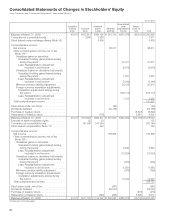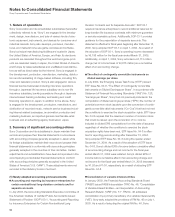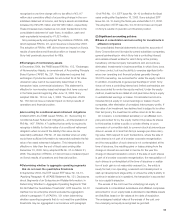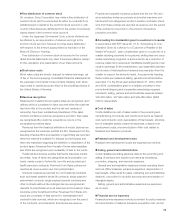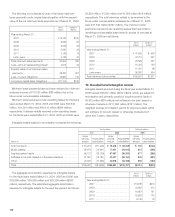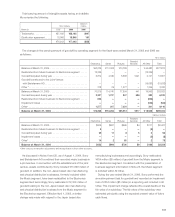Sony 2006 Annual Report Download - page 102
Download and view the complete annual report
Please find page 102 of the 2006 Sony annual report below. You can navigate through the pages in the report by either clicking on the pages listed below, or by using the keyword search tool below to find specific information within the annual report.100
other operating costs such as personnel expenses, depreciation
of fixed assets, and office rental of subsidiaries in the Financial
Services segment.
■ Advertising costs
Advertising costs are expensed when the advertisement or
commercial appears in the selected media, except for advertising
costs for acquiring new insurance policies which are deferred
and amortized as part of insurance acquisition costs.
■ Shipping and handling costs
The majority of shipping and handling, warehousing and internal
transfer costs for finished goods are included in selling, general
and administrative expenses. An exception to this is in the
Pictures segment where such costs are charged to cost of sales
as they are integral part of producing and distributing the film
under SOP 00-2, “Accounting by Producers or Distributors of
Films”. All other costs related to Sony’s distribution network are
included in cost of sales, including inbound freight charges,
purchasing and receiving costs, inspection costs and warehous-
ing costs for raw materials and in-process inventory. Amounts
paid by customers for shipping and handling costs are included
in net sales.
■ Income taxes
The provision for income taxes is computed based on the pretax
income included in the consolidated statements of income. The
asset and liability approach is used to recognize deferred tax
assets and liabilities for the expected future tax consequences
of temporary differences between the carrying amounts and the
tax bases of assets and liabilities. Sony records valuation
allowances to reduce deferred tax assets to the amount that
management believes is more likely than not to be realized. In
assessing the likelihood of realization, Sony considers all
currently available evidence for future years, both positive and
negative, supplemented by information of historical results for
each tax jurisdiction.
■ Net income per share
Prior to December 1, 2005, Sony calculated and presented per
share data separately for Sony’s common stock and for the
subsidiary tracking stock by the “two-class” method based on
FAS No. 128. As the holders of the subsidiary tracking stock
had the right to participate in earnings, together with common
stockholders, under this method, basic net income per share
(“EPS”) for each class of stock was calculated based on the
earnings allocated to each class of stock for the applicable
period, divided by the weighted-average number of outstanding
shares in each class during the applicable period.
The earnings allocated to the subsidiary tracking stock were
determined based on the subsidiary tracking stock holders’
economic interest in the targeted subsidiary’s earnings available
for dividends. As defined by Sony Corporation’s articles of
incorporation, the amount distributable to the subsidiary tracking
stock holders was based on the declared dividends of the
targeted subsidiary, which might only be declared from the
amounts available for dividends of the targeted subsidiary.
The targeted subsidiary’s earnings available for dividends were,
as stipulated by the Japanese Commercial Code, not including
those of the targeted subsidiary’s subsidiaries. If the targeted
subsidiary had accumulated losses, a change in accumulated
losses was also allocated to the subsidiary tracking stock.
The subsidiary tracking stock holders’ economic interest was
calculated as the number of the subsidiary tracking stock
outstanding divided by the number of the targeted subsidiary’s
common stock outstanding subject to multiplying by the
Standard Ratio (tracking stock : subsidiary’s common stock=
1:100, as defined in the articles of incorporation). The earnings
allocated to the common stock were calculated by subtracting
the earnings allocated to the subsidiary tracking stock from
Sony’s net income for the period.
On October 26, 2005, the Board of Directors of Sony
Corporation decided to terminate all shares of subsidiary tracking
stock and convert such shares to shares of Sony common
stock at a conversion rate of 1.114 share of Sony common
stock per share of subsidiary tracking stock. All shares of
subsidiary tracking stock were converted to shares of Sony
common stock on December 1, 2005. As a result of the
conversion, for the fiscal year ended March 31, 2006, Sony
calculated per share data separately for Sony’s common stock
and for the subsidiary tracking stock by the “two-class” method
based on FAS No. 128, but did not present per share data for
the subsidiary tracking stock. The earnings allocated to common
stock for the fiscal year ended March 31, 2006 were calculated
by subtracting the earnings allocated to the subsidiary tracking
stock for the eight months ended November 30, 2005.
The computation of diluted net income per common stock
reflects the maximum possible dilution from conversion, exer-
cise, or contingent issuance of securities including the conver-
sion of Co-Cos regardless of whether the conditions to exercise
the conversion rights have been met.
(3) Recent pronouncements:
■ Accounting for stock-based compensation
In December 2004, the FASB issued FAS No. 123 (revised 2004),
“Share-Based Payment” (“FAS No. 123(R)”). This statement
requires the use of the fair value based method of accounting
for employee stock-based compensation and eliminates the


